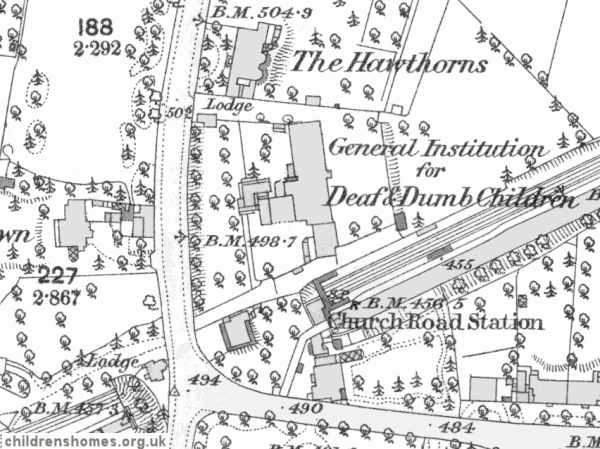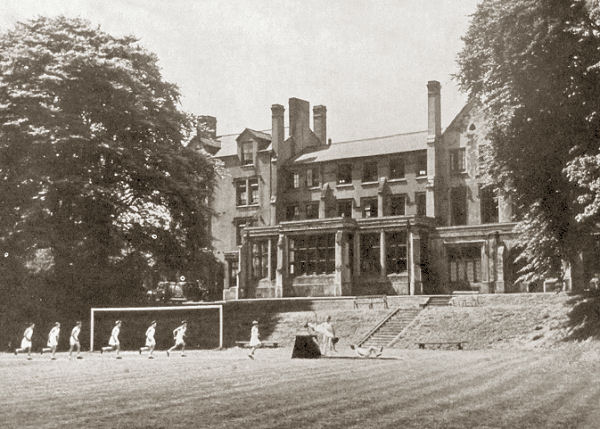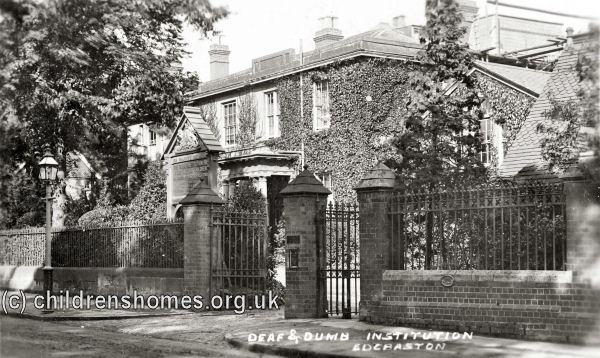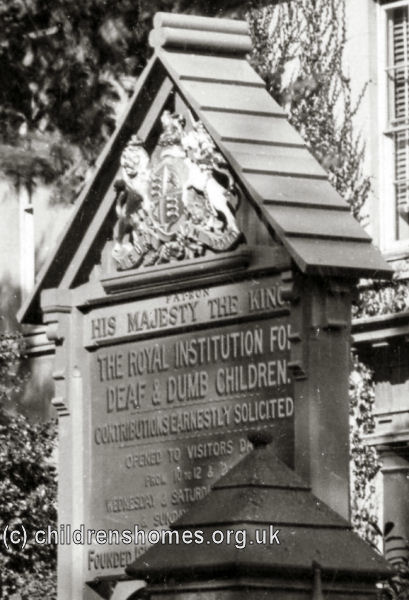Royal Institution for the Instruction of Deaf Children, Birmingham, Warwickshire
What began life as the General Institution for the Instruction of Deaf and Dumb Children, was founded in 1812 by Dr Gabriel Jean Marie de Lys, a Breton refugee from the French Revolution and a physician at the Birmingham General Hospital. In 1814, the Institution moved into purpose-built premises at Church Road, Edgbaston, Birmingham.
The Institution's first head was Thomas Braid, a grandson of the first Thomas Braidwood, who had previously worked at his grandfather's establishment at Hackney. Braidwood used a combination of the oral method — teaching the deaf to articulate the sounds of speech — and the silent system — the use of finger spelling. After Braidwood's death in 1825, he was succeeded as superintendent by Louis de Puget, a Swiss, who had no interest in oralism. The silent system also had the attraction that it did not require the same individual attention as the oral method and so could be used with larger numbers of pupils. This policy was to continue for many years.
In order to provide more places, the Church Road buildings was enlarged in 1835 and again in 1849, when it could accommodate fifty pupils, though as many as eighty were sometimes crowded in. Further major work in 1859, included the addition of an extra storey to the building, the enlargement of the school-rooms, new day rooms, dormitories and lavatories, and a new entrance hall. The work increased the Institution's capacity to 120 places.
On 7 August 1863, the establishment was formally approved to operated as a Certified School, allowing it to receive children boarded out from workhouses by the Poor Law authorities.
Another enlargement in 1875, raised the number of places to 132. The work was described in a newspaper report of the time:
This alteration has been effected in order to meet a constantly, increasing pressure in the boys' department, as well as to give more room for school purposes, the accommodation for which has for some time been very inadequate, and quite insufficient for the proper and efficient carrying on of the instruction and training of the children. Under those circumstances Messrs. Bate man and Corser, architects, of Cherry Street, were consulted, and the alterations and extension have been carried out by the contractor, Mr. Briley, of Kingston Road, in accordance with their plans. These consist of an enlargement of the boys' day room by taking in the lavatory, and a good deal of much-needed additional space has been gained. Beyond the lavatory, the school room was formerly situated, but that has now been converted into an excellent, dry play-ground, by rebuilding the school room and placing it on the first floor over the play-ground. The floor of the latter is partly bricked and partly covered with sawdust and tan for gymnastic exercises, in which the boys take a good deal of delight. The large and commodious play-ground adjoins, and here again there are all the necessary appliances for the recreation, amusement, and physical development of the children. A much larger and better-ventilated lavatory has been obtained by this arrangement at one end of the covered playground; while at the other, between it and the day room, an assistant master's room has been provided, from which windows command the two play-grounds, the day room and the passage leading from the latter to the former. Complete supervision of the boys by lie assistant-master is thus secured, and the new arrangement is consequently a vast improvement upon the old one, affording, as it does, the means of enforcing the strictest discipline amongst the boys. These are excellent and important points gained by the recent alterations, and will greatly conduce to the good management of the institution. The school room, as already stated, has ben rebuilt and entirely rearranged, and is now on the first instead of the ground floor. It is reached by a flight of stone steps from the boys' day room, and it is a lofty, well-proportioned room, measuring 60 feet by 36 feet. The middle part of the floor is raised, in order that the children sitting at one row of desks may see over the heads of those in front of them, and running along three sides of this room, about on a level with the eyes of the children, is a series of tablets, upon which the lessons, or tho illustrations of tho lessons, are marked. At the end of the room is a platform, from which the whole of the children can be addressed at once. A minor arrangement, but one, perhaps, worth mentioning is the substitution of small stools at tho desks for the usual forms, taken from a plan adopted at the Orphanage, Erdington, and giving to each child a separate seat. But as economy enters into the whole conduct of the institution, so here again it is rigidly practised by the committee, for they only introduce the luxury of the separate seats as the old forms become worn out. The ventilation, too, has not been lost sight of, and, by the adoption of a plan recommended by the medical attendant, this important sanitary arrangement is both efficient and sufficient, and does not subject the children to the least inconvenience. To complete the arrangements for the school room, gas has been introduced, the principal part of the fittings being the grift of Messrs. R.W. Winfield and Co. 'These form the chief structural alterations; but, in order to make room for an additional number of children, the boys' dormitory over the day room has been enlarged, and it will now contain twelve more beds, giving the increased accommodation for the extra boys who will be admitted into the institution during the ensuing year. Each child has a separate bed, and the dormitories are well ventilated, and fitted up with every regard to the health and comfort of the inmates. The assistants' bed rooms, too, adjoin the dormitories, so that here, as in other parts of the institution, the strictest watch is kept upon the discipline of the children. A separate room is set apart as an infirmary, in which sick children are treated, but, although some of them are now absent through illness, those in the institution are all in good health, and the infirmary is therefore empty. The girls' department occupies one half of the building, and it is almost a counterpart of that of the boys', from which it is carefully separated by separate staircases leading to the dormitories, and by the rooms of the officers. On this side of the institution the only alteration is the enlargement and improvement of the laundry and wash-houses, and the work done there is by no means an unimportant part of the school training, for many of the girls become exceedingly good laundresses, and thereby able to get their own living after leaving the institution. The boys and girls have their meals in the same room which is also used as the girls' day-room; and even here the two sexes are not allowed to mix together, but have separate tables. The walls of this room are decorated with an excellent collection of pictures, giving, it a bright and cheerful appearance, and materially assisting, no doubt, in the formation of a taste for drawing, which is taught in the school.
The Institution site is shown on the 1887 map below.

Institution for Deaf Children site, Birmingham, c.1887.
Further enlargements of the school rooms and dormitories in 1887 increased the establism=hment's capacity to around 190 places. In the same year, the Instiution was granted the privilege of adding the prefix 'Royal' to its name, replacing the word 'General'.
In 1890, the institution's admission regulations were as follows:

Royal Institution for the Instruction of Deaf Children, Birmingham.
The Institution site subsequently expanded by acquiring neighbouring properties to the north of the original building, beginning with a large villa known as the Hawthorns.

The Hawthorns block of the Royal Institution for the Instruction of Deaf Children, Birmingham.

Royal Institution for the Instruction of Deaf Children, Birmingham.
In 1930, the word 'Dumb' was dropped from theorganisation's name, and in 1935 it adopted the title the 'Royal School for Deaf Children, Birmingham.'
The school closed in1984. The original building was subsequently demolished and the Sunrise care home now occupies the site. The properties to the north have been refurbished as a residential complex known as St George's Place.
Records
Note: many repositories impose a closure period of up to 100 years for records identifying individuals. Before travelling a long distance, always check that the records you want to consult will be available.
- Birmingham Archives and Heritage Service, Library of Birmingham, Centenary Square, Broad Street, Birmingham B1 2ND.
Census
Bibliography
- Higginbotham, Peter Children's Homes: A History of Institutional Care for Britain's Young (2017, Pen & Sword)
- Pritchard, D.G., Education and the Handicapped 1760-1960 (1963, Routledge & Kegan Paul)
- Watson, J, Instruction of the Deaf and Dumb (1809)
- Watson, Thomas J., A History of Deaf Education in Scotland 1760-1939 (Unpublished PhD Thesis, University of Edinburgh, 1949)
Links
Except where indicated, this page () © Peter Higginbotham. Contents may not be reproduced without permission.


